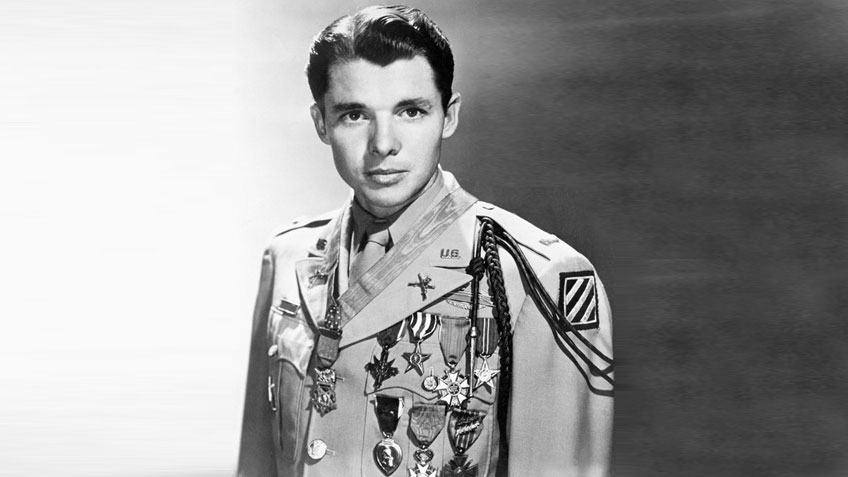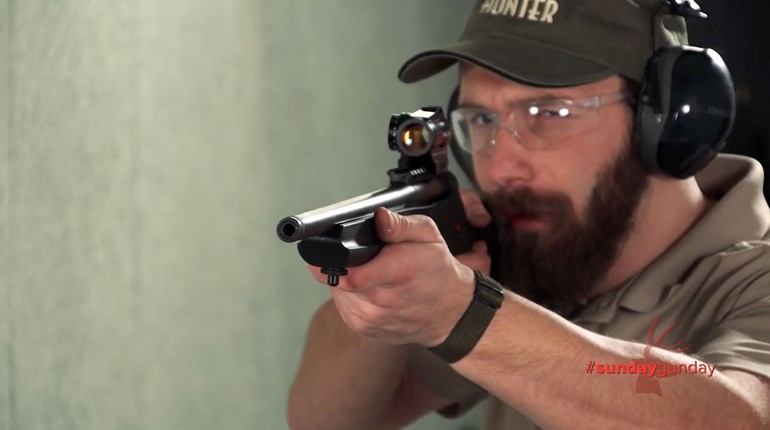
During the golden age of Hollywood, few stars shone more brightly than those who donned Stetsons, and portrayed cowboys on sets mocked up like old-time Western plains. Though there were many in this popular genre, including such legends as John Wayne and Gary Cooper, one Audie Murphy is always remembered among the best, due not only to his acting, but to his estimable character and personal history. Audie, as it happened, was the most decorated soldier of the Second World War, receiving every military combat award for valor available from the U.S. Army, the Medal of Honor, and numerous French and Belgian awards for heroism.
Mr. Murphy’s story reads like a fictional tale, but his short life really was just that eventful. Born in 1925, to a sizeable family of sharecroppers in Hunt County, Texas, Audie was forced to leave school in fifth grade to pick cotton and work odd jobs to support his family. His father had run off by then, and his mother was to die a few years later during his adolescence, but Audie persevered, keeping his family fed by means of hard work and a steady hunting rifle. This state of affairs was not to last, however. As it did for so many young men, reality changed for young Murphy on December 7th, 1941, when his love of country saw him thrust forth into an international war, the scale of which he likely could not begin to fathom.
Being too young to serve at the outset of the war, Audie solicited the help of his sister in forging documentation to facilitate his enlistment. The process was still not an easy one. Audie was first rejected from the Marine Corps for being too small, and then rejected from the paratroopers. Finally though, he successfully joined the US Army Infantry.
Audie’s first assignment was to the 15th Regiment, 3rd Infantry Division in North Africa, with which he saw his first action during the invasion of Sicily in 1943. After landing at Salerno, Audie’s natural grasp of small-unit tactics, alongside his proficiency as a marksman, enabled him to rise rapidly throughout the ever-thinning ranks of his superior officers. Upon the capture of Rome, at which point he was already a Staff Sergeant, Audie earned what was to be the first of many decorations for gallantry.
Pushing northward from there, Audie and his unit played a seven-week role in Operation Anvil-Dragoon, the invasion of southern France which saw the unit lose 4,500 men. Audie soldiered on nonetheless, and was given a battlefield promotion, this time to 2nd Lieutenant, for his extraordinary prowess under fire. Though already a seasoned veteran, with more battles and wounds to his name than most will see in a lifetime, Audie yet stood only on the cusp of his legend.
Holtzwihr, 26 January, 1945. The frigid air around him measuring a mere 14 degrees, and the snow underfoot piling to 2 full feet, Audie Murphy was on high alert. His B Company, decimated over the last few days of fighting, had been attacked just moments before by 250 German infantry alongside six tanks; an onslaught they could not withstand. After wisely sounding a retreat into the safety of the woods, Audie rushed back to the front, expending the last of his carbine ammunition at the approaching enemy, while calling in airstrikes over a radio. Finally, with the advancing Germans closing to within 50 yards of his position, Audie made a split decision that would forever etch his name into history. Jumping astride a burning tank destroyer, Audie seized the attached .50-caliber machine gun, and began to mow down enemy ranks.
Though the hostiles managed to advance within 10 yards of Audie’s withering fire, the lone Texan held fast. The surviving Germans, deathly afraid of the .50-caliber’s armor-piercing capabilities, were slowed, then seemed almost transfixed, before returning to the safety of an area just in front of the Allied-occupied woods. The tanks, without their contingent of infantry support, were also forced to turn back.
It was not yet over for Murphy, however. From their position of relative safety, the German tanks continued to batter Audie with fire, while the infantry attacked in waves. Ironically, the fire threatening to explode Audie’s destroyer for now kept him safe, as the smoke and flame made it impossible for the Germans to determine the point whence the machine gun fire came. Despite several direct hits to the base of the destroyer, Audie maintained his position, only pausing to reload. From here, he directed artillery strikes on the ever-pressing enemy, eventually having them mark the enemy’s position with smoke for incoming bombers to pummel. This combined with the repeated artillery strikes, many of which Audie called in right on top of his own position, finally ended all hope of a German advance and forced them to turn back and retrench for good.
Just as German pressure subsided, Audie’s field telephone gave out, prompting him to return to his lines battered and bloodied. Soon after reaching the safety of the woods, Audie heard the destroyer he had manned finally explode, but not even this could faze him sufficiently to prompt a rearward glance. The entire way back to his lines, Audie’s gaze was fixed straight ahead, with single-minded purpose. Undaunted, and stubbornly refusing evacuation upon his return, Murphy rallied his men and led them in a counterattack which dislodged the Germans from the entire area, regaining Company B’s original position. For his achievements that day, Lieutenant Murphy was awarded the Medal of Honor by Lt. Gen. Alexander Patch, commanding General of the Seventh Army.
After coming home to the States, Audie was not destined to live a quiet life. Invited to Hollywood by James Cagney, who had seen him on the iconic cover of Life magazine, Audie soon made quite a name for himself in film. He eventually starred in over 40 movies, including The Red Badge of Courage, Kansas Raiders, and even his own story: To Hell and Back.
Plagued constantly by what was known at the time as “shell-shock,” Audie was beset by insomnia and depression until the end of his days. In an effort to bring attention to the condition, which by then was afflicting Korean War and Vietnam veterans, Audie did what few others were comfortable doing at the time, and spoke out about his own suffering. Calling constantly upon the government to increase consideration and study on the effects of wartime trauma on the human mind, Audie played a vocal role in encouraging the medical breakthroughs which eventually led to the classification and treatment of PTSD. For his efforts, the Audie L. Murphy VA Hospital was dedicated to him in San Antonio, in 1973.
Audie, unfortunately, had already been dead over a year by then. On May 28, 1971, he was killed alongside 5 others when a private plane he was riding in hit bad weather and crashed into Brush Mountain near Catawba, Virginia. A monument stands at the site to this day, right on the Appalachian Trail. It serves as a stark reminder to all who pass by on their 2,181-mile journey, that a man whose boots had gone decidedly further, there drew his last breath.






































